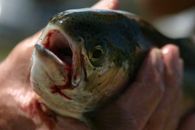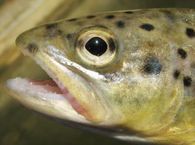 Many fly fishermen are conservation conscious. They love to fish for the sport of it and not necessarily to put food on the table.
Many fly fishermen are conservation conscious. They love to fish for the sport of it and not necessarily to put food on the table.
For this reason these anglers practice catch and release.
Some fly fishing anglers do keep some of their catch as food for their family and friends. If they catch all that they need for a good fish dinner, they release the rest. This ensures that fish will be plentiful in our waters for years to come.
If you are new to fly fishing, here are some things you should know about the art of catch and release.
How To Practice Catch & Release
If possible, fish with a barbless hook. If all you have are barbed hook, remove or crush the barb.
This allows you to practice catch and release without causing unnecessary injury to the fish.
When practicing catch and release, don’t play the fish any longer than is absolutely necessary. That way, when you release it, the fish will be able to go on its way without being exhausted.
As you’re removing the hook from the fish’s mouth, be sure to hold the fish beneath the water surface while using needle-nosed pliers to dislodge the hook.
This method of catch and release gives the fish a much greater chance of survival.
If the fish you are releasing is exhausted, do this: hold one hand beneath its belly for support and put the other hand around the caudal wrist at the tail. Gently move the fish back and forth, being sure that water flows over the gills after entering the mouth. This allows the fish to recuperate fully. When you feel the fish try to swim away, release it. Always handle catch and release fish as gently as possible.
It isn’t a good idea to keep only large fish (like muskie and pike) and release only the smaller ones (like panfish). Larger fish are more genetically able to spawn and the larger ones allow the fish species to remain in optimum health. In fact, wise anglers keep the small fish for eating and allow the larger and more superior spawners to go about their business of revitalizing the species.
Never assume that catch and release is a foolproof way to ensure fish species survival. Fish can still be seriously injured when anglers practice catch and release, unless great care is taken. Plus, even fish which are not injured can die from stress if not handled properly.
Practicing catch and release when fly fishing can greatly increase the survival of fish species and ensure that future generations have an opportunity to enjoy the adventure of fly fishing.





